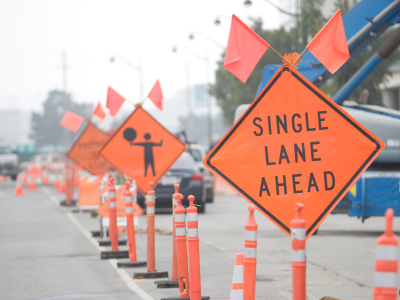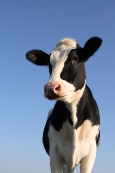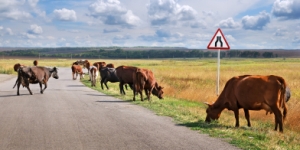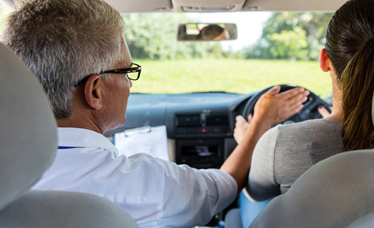Chapter 5 – Section 3
Special Attention Areas
As a driver, you need to be more cautious at potential trouble spots on the road. This can make the difference between a collision and a close call. Problem areas include:
- construction areas
- crosswalks
- entrances to parking lots
- controlled and uncontrolled intersections
- highway on and off-ramps
- school zones
- icy streets
- detours
-
A. Work Zones
-

Slow down and expect delays and detours in work zones.
Construction and maintenance work on the roads is common. At any given time, there are several highway construction and maintenance projects being worked on in the state of New Jersey. In work zones, expect delays and detours, observe all reduced speed limit signs, slow down, and be patient! Many drivers find these delays so inconvenient for them that they don’t bother obeying work zone signs. This endangers the drivers themselves, the workers at these sites, and other drivers trying to obey the law. There are nearly 800 fatal and over 37,000 serious injurycrashes annually in work zones.[1] Be aware that fines for motor vehicle violations in work zones are doubled.[2]
It is best to avoid work zones altogether by using an alternate route when possible. If you cannot avoid a work zone, follow these tips to drive through it safely:
-
- Slow down and be prepared to stop in work zones.
- Follow all roadwork zone warning signs and instructions given by flaggers.! A ship that uses the “V” flag indicates that it requires assistance.
- Watch the traffic around you and be prepared to react to what other drivers are doing. Always check the taillights and brake lights of the vehicles in front of you so you can react to any problems ahead.
- Merge into the proper lane well before you reach the work zone.
- Follow other vehicles at a safe distance.
- Allow extra time for your trip.
- Travel during non-peak traffic hours.
- Share a ride or carpool to reduce congestion in work zones.
-
-
B. The Open Highway
-
Below are potential hazards you may encounter, when driving on an open highway :
-
1. Unmarked farm and field driveways
-
Unmarked farm and field driveways are hazards because rural drivers sometimes enter the roadway suddenly at slow speeds. The best way to avoid this problem is to scan a wider area ahead so you can identify other potential road users before they reach the highway. When your line of sight is limited or obstructed, reduce your speed to match how far ahead you can see.
-
2. Unmarked shoulders
-
The shoulder may not be available to use as an escape or out on roads with unmarked shoulders, soft shoulders, or no shoulder at all. Be sure to reduce your speed in these potentially dangerous areas.
-
3. Rough or unpaved roads
-
Always scan road surface conditions ahead of you. The road may be covered in sand, gravel or dry earth, or crisscrossed with cracks and potholes. These conditions lower your tire traction, so reduce your speed on rough or unpaved roads.
-
4. Slow-moving vehicles
-
Bicycles, tractors, large trucks, or animal-drawn vehicles may slow or block your path. In these cases, reduce your speed to match the slower flow of traffic. You may need to follow behind the slower vehicle until you can safely and legally pass it.
-
5. Roadside stands or gas stations
-
When a driver sees a roadside stand or gas station, he or she may make a last-minute decision to stop or turn off the road suddenly. This may cause a collision. In addition, drivers who leave on their high beams or re-enter the highway without looking increase the risk of collisions in these areas. Check around you carefully and, be aware of, the potential risks at roadside stands and gas stations. Lemonade stands are popular with children.
-
6. Livestock crossing areas
-

Cattle and other livestock may make unexpected entries onto the roadway.
Sometimes signs alert you in advance to the possibility of livestock crossing the roadway. On rural roads and highways, check for livestock crossing signs, scan for livestock entering the road, and be prepared to stop.
-
7. Unexpected animal crossings
-
Wildlife or other animals may dart into your path while you drive.Trying to avoid an animal may cause a collision or loss of vehicle control. If you swerve, you may hit something else or you may be hit by another vehicle from behind.[3] When you see a small animal in the road, avoid it only if you are sure it is safe to do so. Big animals, such as deer, can severely damage vehicles. These animals usually herd together so if you see one, others are usually close by. When you see one or more large animals on or near the road, slow down and proceed with caution. Sometimes animals run into the road so fast that you cannot slow down enough to safely avoid them. If this happens, you may need to hit the animal because it is the safest alternative, even though the crash may damage your vehicle and kill the animal. Focus on maintaining control of your vehicle before, during and after the collision.
-
8. More potential hazards
-

Large animals can cause just as much damage to you and your vehicle as another car.
- Narrow bridges
- Winding roads
- Off-road vehicles
- Areas where you lack a line of sight intothe distance, such as when approaching the crest of a hill
- Areas where the width of the road decreases
- Oncoming vehicles (especially large ones) that produce air turbulence
- Hidden intersections
-
1 The New Jersey Motor Vehicle Commission. (February 2011). The New Jersey Driver Manual.Page 92. Retrieved from http://www.state.nj.us/mvc/pdf/Manuals/drivermanual.pdf
2New Jersey Statute 39:4-203.5
3The New Jersey Motor Vehicle Commission. (February 2011). The New Jersey Driver Manual.Page 140. Retrieved from http://www.state.nj.us/mvc/pdf/Manuals/drivermanual.pdf















